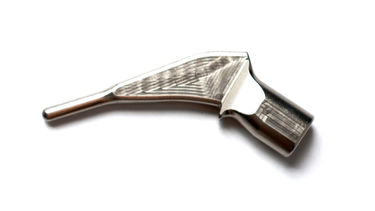The design of titanium orthopaedic parts presents technical challenges, such as chemical biocompatibility with the human body, mechanical-elastic compatibility with bone tissue, wear compatibility at the implant/tissue interface and ultimately the optimum adhesion of the implant. As demand for these products increases it becomes ever more important to produce them cost effectively and material efficiently.
Royce at the University of Sheffield has been working in collaboration with Sheffield based medical manufactuing company JRI Orthopaedics Ltd to demonstrate that hip joints can be manufactured in two steps from powder;
(1) field-assisted sintering technology followed by
(2) machining and coating.
Such a novel solid state processing route produces hip joint with forged properties and uses oversized powder that cannot be used in the growing additive manufacturing market.
Royce at the University of Sheffield uses its large scale Field Assisted Sintering Technology (FAST) equipment, the FCT 250, to consolidate waste Ti-6Al-4V powder into billets that JRI Orthopaedics are then able to machine and coat through their standard procedures at their own facilities.
FAST offers a rapid, low cost route to recycle alternative powder sources into near net shapes for machining and provides an opportunity to functionally grade hip joints with lower modulus alloys that match bone tissue. Such a sustainable solid-state route is important for titanium, so as to better utilise the excellent properties of titanium coupled with an efficient use of this expensive material. This method would allow hip joint designers wider scope and opportunities in the future.


